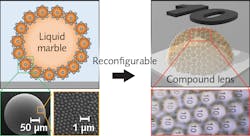Microfluidic liquid marbles form mosquito-like hydrophobic compound eyes
The ability to mimic nature—biomimetics—provides scientists a roadmap to fabricate complex micro- and nanoscale structures that take on the useful functions of the plant or animal being duplicated. Using microfluidics, nanoparticles, and patterned surfaces in a reproducible and scalable process, researchers at Johns Hopkins University (Baltimore, MD) were able to create lens arrays from ‘liquid marbles’ that achieve the corresponding wide field of view, nearly infinite depth of field, peripheral vision without aberration, and even anti-fogging properties achieved by the compound eyes of mosquitoes.
In their analysis of the mosquito-eye structure, they observed that unlike many other compound eyes consisting of lenslet arrays on concave or convex surfaces that fan out like a flower or are created through nanoparticle assembly, the individual lenslets on the mosquito eyes had their own nanoscale structures that enabled water-repellant properties. To mimic this structure, the process begins with silicon nanoparticles (120–600 nm diameter) dispersed in a microfluidically dispensed UV-curable oil droplet or microlens (25–250 µm radius). The refractive-index-matched nanoparticles self-assemble on the droplet surface through capillary action and form a nanoparticle-covered ‘liquid marble’ without using any complex microfabrication or direct-write methods. Upon UV curing, these marbles are rolled into convex (in the case of the mosquito eye) or concave nanopatterned, oil-filled templates (of radius 0.5–5.0 mm) and again cured as a structure, resulting in compound lenses with focal lengths from 325 to 650 µm that offer nearly infinite depth of field and a 149º field of view. Beyond these superior optical properties, the compound-eye structures are superhydrophobic (water-repellant) in a convex form or can even be super-wetting (superhydrophilic) in a concave form. Reference: D. Shin et al., ACS Appl. Mater. Interfaces, 11, 34478–34486 (2019).

Gail Overton | Senior Editor (2004-2020)
Gail has more than 30 years of engineering, marketing, product management, and editorial experience in the photonics and optical communications industry. Before joining the staff at Laser Focus World in 2004, she held many product management and product marketing roles in the fiber-optics industry, most notably at Hughes (El Segundo, CA), GTE Labs (Waltham, MA), Corning (Corning, NY), Photon Kinetics (Beaverton, OR), and Newport Corporation (Irvine, CA). During her marketing career, Gail published articles in WDM Solutions and Sensors magazine and traveled internationally to conduct product and sales training. Gail received her BS degree in physics, with an emphasis in optics, from San Diego State University in San Diego, CA in May 1986.
